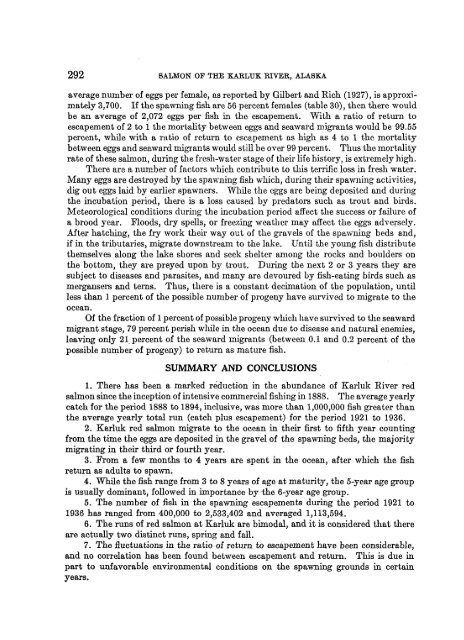Fishery bulletin of the Fish and Wildlife Service - NOAA
Fishery bulletin of the Fish and Wildlife Service - NOAA
Fishery bulletin of the Fish and Wildlife Service - NOAA
Create successful ePaper yourself
Turn your PDF publications into a flip-book with our unique Google optimized e-Paper software.
292 SALMON OF THE KAKLTJK KIVER, ALASKA<br />
average number <strong>of</strong> eggs per female, as reported by Gilbert <strong>and</strong> Rich (1927), is approximately<br />
3,700. If <strong>the</strong> spawning fish are 56 percent females (table 30), <strong>the</strong>n <strong>the</strong>re would<br />
be an average <strong>of</strong> 2,072 eggs per fish in <strong>the</strong> escapement. With a ratio <strong>of</strong> return to<br />
escapement <strong>of</strong> 2 to 1 <strong>the</strong> mortality between eggs <strong>and</strong> seaward migrants would be 99.55<br />
percent, while with a ratio <strong>of</strong> return to escapement as high as 4 to 1 <strong>the</strong> mortality<br />
between eggs <strong>and</strong> seaward migrants would still be over 99 percent. Thus <strong>the</strong> mortality<br />
rate <strong>of</strong> <strong>the</strong>se salmon, during <strong>the</strong> fresh-water stage <strong>of</strong> <strong>the</strong>ir life history, is extremely high.<br />
There are a number <strong>of</strong> factors which contribute to this terrific loss in fresh water.<br />
Many eggs are destroyed by <strong>the</strong> spawning fish which, during <strong>the</strong>ir spawning activities,<br />
dig out eggs laid by earlier spawners. While <strong>the</strong> eggs are being deposited <strong>and</strong> during<br />
<strong>the</strong> incubation period, <strong>the</strong>re is a loss caused by predators such as trout <strong>and</strong> birds.<br />
Meteorological conditions during <strong>the</strong> incubation period affect <strong>the</strong> success or failure <strong>of</strong><br />
a brood year. Floods, dry spells, or freezing wea<strong>the</strong>r may affect <strong>the</strong> eggs adversely.<br />
After hatching, <strong>the</strong> fry work <strong>the</strong>ir way out <strong>of</strong> <strong>the</strong> gravels <strong>of</strong> <strong>the</strong> spawning beds <strong>and</strong>,<br />
if hi <strong>the</strong> tributaries, migrate downstream to <strong>the</strong> lake. Until <strong>the</strong> young fish distribute<br />
<strong>the</strong>mselves along <strong>the</strong> lake shores <strong>and</strong> seek shelter among <strong>the</strong> rocks <strong>and</strong> boulders on<br />
<strong>the</strong> bottom, <strong>the</strong>y are preyed upon by trout. During <strong>the</strong> next 2 or 3 years <strong>the</strong>y are<br />
subject to diseases <strong>and</strong> parasites, <strong>and</strong> many are devoured by fish-eating birds such as<br />
mergansers <strong>and</strong> terns. Thus, <strong>the</strong>re is a constant decimation <strong>of</strong> <strong>the</strong> popxilation, until<br />
less than 1 percent <strong>of</strong> <strong>the</strong> possible number <strong>of</strong> progeny have survived to migrate to <strong>the</strong><br />
ocean.<br />
Of <strong>the</strong> fraction <strong>of</strong> 1 percent <strong>of</strong> possible progeny which have survived to <strong>the</strong> seaward<br />
migrant stage, 79 percent perish while in <strong>the</strong> ocean due to disease <strong>and</strong> natural enemies,<br />
leaving only 21 percent <strong>of</strong> <strong>the</strong> seaward migrants (between 0.1 <strong>and</strong> 0.2 percent <strong>of</strong> <strong>the</strong><br />
possible number <strong>of</strong> progeny) to return as mature fish.<br />
SUMMARY AND CONCLUSIONS<br />
1. There has been a marked reduction in <strong>the</strong> abundance <strong>of</strong> Karluk River red<br />
salmon since <strong>the</strong> inception <strong>of</strong> intensive commercial fishing in 1888. The average yearly<br />
catch for <strong>the</strong> period 1888 to 1894, inclusive, was more than 1,000,000 fish greater than<br />
<strong>the</strong> average yearly total run (catch plus escapement) for <strong>the</strong> period 1921 to 1936.<br />
2. Karluk red salmon migrate to <strong>the</strong> ocean in <strong>the</strong>ir first to fifth year counting<br />
from <strong>the</strong> time <strong>the</strong> eggs are deposited in <strong>the</strong> gravel <strong>of</strong> <strong>the</strong> spawning beds, <strong>the</strong> majority<br />
migrating in <strong>the</strong>n- third or fourth year.<br />
3. From a few months to 4 years are spent in <strong>the</strong> ocean, after which <strong>the</strong> fish<br />
return as adults to spawn.<br />
4. While <strong>the</strong> fish range from 3 to 8 years <strong>of</strong> age at maturity, <strong>the</strong> 5-year age group<br />
is usually dominant, followed in importance by <strong>the</strong> 6-year age group.<br />
5. The number <strong>of</strong> fish in <strong>the</strong> spawning escapements during <strong>the</strong> period 1921 to<br />
1936 has ranged from 400,000 to 2,533,402 <strong>and</strong> averaged 1,113,594.<br />
6. The runs <strong>of</strong> red salmon at Karluk are bimodal, <strong>and</strong> it is considered that <strong>the</strong>re<br />
are actually two distinct runs, spring <strong>and</strong> fall.<br />
7. The fluctuations in <strong>the</strong> ratio <strong>of</strong> return to escapement have been considerable,<br />
<strong>and</strong> no correlation has been found between escapement <strong>and</strong> return. This is due in<br />
part to unfavorable environmental conditions on <strong>the</strong> spawning grounds in certain<br />
years.

















